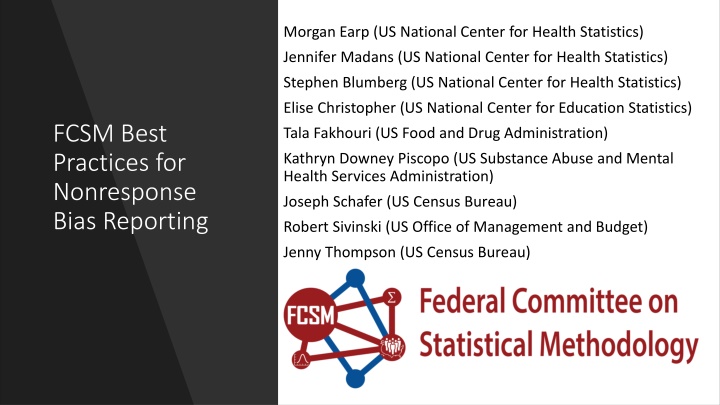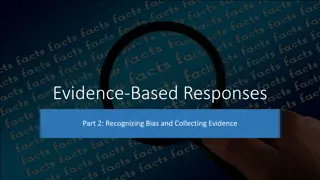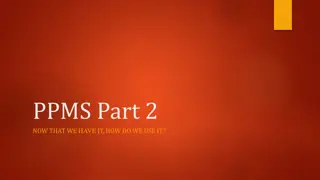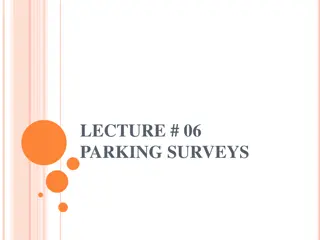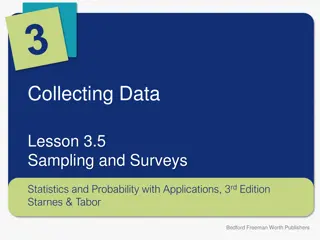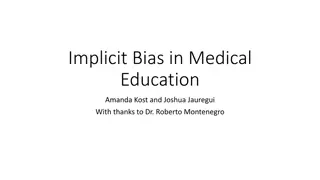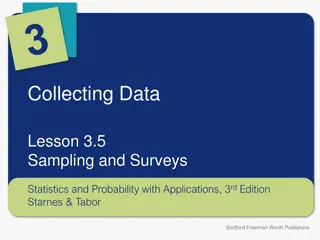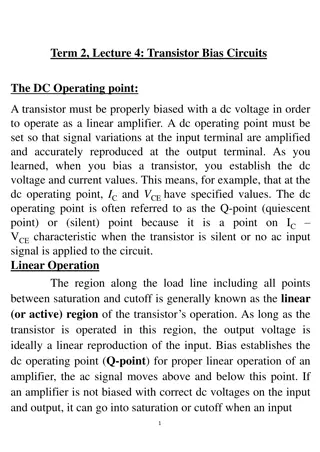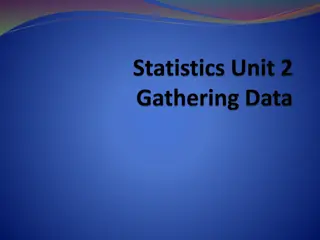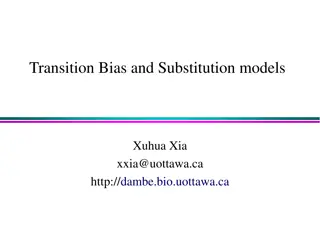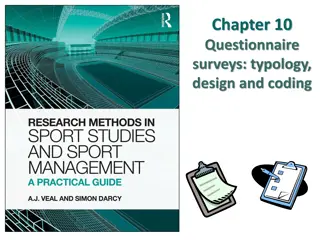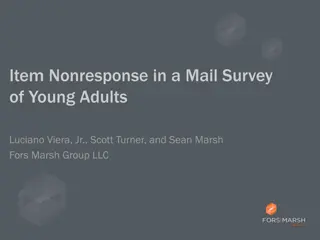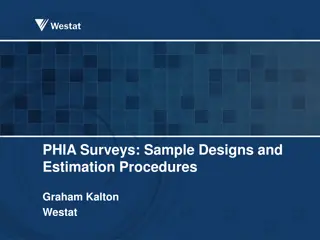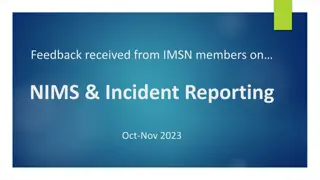Best Practices for Nonresponse Bias Reporting in Federal Surveys
This content presents the best practices and guidelines for reporting nonresponse bias analysis in federal surveys. It covers describing the survey subject, unit response rates, evaluation plans, and mitigation strategies. The aim is to provide a common framework for federal agencies to conduct and disseminate nonresponse bias research effectively.
Download Presentation

Please find below an Image/Link to download the presentation.
The content on the website is provided AS IS for your information and personal use only. It may not be sold, licensed, or shared on other websites without obtaining consent from the author.If you encounter any issues during the download, it is possible that the publisher has removed the file from their server.
You are allowed to download the files provided on this website for personal or commercial use, subject to the condition that they are used lawfully. All files are the property of their respective owners.
The content on the website is provided AS IS for your information and personal use only. It may not be sold, licensed, or shared on other websites without obtaining consent from the author.
E N D
Presentation Transcript
Morgan Earp (US National Center for Health Statistics) Jennifer Madans (US National Center for Health Statistics) Stephen Blumberg (US National Center for Health Statistics) Elise Christopher (US National Center for Education Statistics) FCSM Best Practices for Nonresponse Bias Reporting Tala Fakhouri (US Food and Drug Administration) Kathryn Downey Piscopo (US Substance Abuse and Mental Health Services Administration) Joseph Schafer (US Census Bureau) Robert Sivinski (US Office of Management and Budget) Jenny Thompson (US Census Bureau)
Official Disclaimers Official Disclaimers The best practices and guidelines presented in this session are an interim product. Target final version: March 2022 The FCSM welcomes comments Any views expressed on statistical issues or operational procedures are those of the authors and not necessarily those of the U.S. Census Bureau. The Census Bureau has reviewed this data product for unauthorized disclosure of confidential information and has approved the disclosure avoidance practices applied. (Approval ID:CBDRB-FY22- ESMD001-002)
The Best Practices and Guidelines The Best Practices and Guidelines Provide a common framework for reporting and disseminating nonresponse bias analysis research conducted by federal agencies General language designed to cater to the variety of surveys administered by federal agencies Discuss what should be included in a nonresponse bias analysis report Provides basic information on nonresponse bias analysis methods Provides references where additional information can be found Not a primer on methods of nonresponse bias analysis
Purpose of presentation Purpose of presentation Introduce (proposed) best practices and guidelines Illustrate selected guidelines using fictional examples Conceptual/clarifying Not intended as prototypes Not intended to serve as examples for style, formatting, etc. Obtain informed feedback on (proposed) best practices and guidelines
Best Practice 1: Describe the survey that is the subject of the nonresponse bias analysis Best Practice 2: Provide unit response rates for the survey and discuss potential for nonresponse bias Best Practice 3: Describe the plan for evaluating and quantifying nonresponse bias and for any mitigation strategies to be employed FCSM Best Practices for Nonresponse Bias Reporting Best Practice 4: Describe and justify all available sources of auxiliary data used in the nonresponse bias analysis Best Practice 5: Describe results of nonresponse bias analysis for all key survey items Best Practice 6: Summarize the major conclusions of the analyses Best Practice 7: Discuss recommendations for data collection methods and adjustment strategies to mitigate nonresponse bias in future waves of data collection
Best Practice 1: Describe the survey Best Practice 1: Describe the Survey Best Practice 1: Describe the Survey the survey Guidelines Provide detailed information on the target population, survey unit, sample design, and data collection modes, as well as the sponsoring agency, the year the study was conducted, and the years of survey data used for the analyses. 1.1. Describe the survey target population 1.2. Describe the survey sample frame 1.3. Discuss the potential for coverage error of the frame 1.4. Describe the survey sample design Checklist for NRB Analysis Report Survey description included Sponsoring agency acknowledged Year of study provided Years of survey data used provided 1.5. Describe the sample unit 1.6. Describe the survey data collection modes 1.7. Describe the survey s key survey items, and identify those that will be used in the nonresponse bias analysis 1.8. Describe any nonresponse mitigation strategies employed during data collection
Best Practice 1: Fictional Example 1 Best Practice 1: Fictional Example 1 Time Use Survey (Students) Time Use Survey (Students) 2019 2019 Target Population High school students (grades 9-12) Sampling frame 1. Listings of public and private high schools from state governments 2. Registries within sampled schools Frame coverage issues Home schooled students Transfer students/dropouts Sample design Two stage cluster sample: 1. PPS selection of schools within state, stratified by public versus private status 2. Systematic sample of students within grade in sample schools Sample unit PSU: High schools USU: Student Data collection modes Personal interview, Telephone follow-up, Web collection Key items Only report mitigation activities that include an evaluation of bias reduction. Time usage: classroom, homework, sports & leisure activities (group), social media, other Nonresponse mitigation strategies employed during data collection Field Experiment: Incentive offered ($10 VISA card) for students in historically low-responding schools
Best Practice 1: Fictional Example 2 Best Practice 1: Fictional Example 2 Athletic Shoe Sales (Stores) Athletic Shoe Sales (Stores) - - 2019 2019 Target Population Target Population Stores that sell athletic shoes Stores that sell athletic shoes Sampling frame Sampling frame Business register Business register Frame coverage issues Frame coverage issues Misclassification on frame Misclassification on frame New stores (births) New stores (births) Sample design Sample design One-stage stratified simple-random sample One-stage stratified simple-random sample Sample unit Sample unit (Business) establishments (Stores) (Business) establishments (Stores) Data collection modes Data collection modes Web collection (primary); telephone follow-up Web collection (primary); telephone follow-up Key items Key items Total revenue, total revenue from athletic shoe sales Total revenue, total revenue from athletic shoe sales Nonresponse mitigation strategies employed during data collection employed during data collection Not reported (no special evaluations or experiments) Not reported (no special evaluations or experiments) Nonresponse mitigation strategies
Best Practice 2 Best Practice 2: Provide unit response rates for the Provide unit response rates for the survey and discuss potential for nonresponse bias survey and discuss potential for nonresponse bias Response rates are unit-level performance metrics that measure the proportion of the eligible sample units that responded to survey or census. Guidelines Guideline 2.1. Identify and report unit response rates based on weights that adjust for selection probabilities Checklist for NRB Report Method of calculating response rates provided. Response rates are reported for the survey (total) and by subdomains of interest for all study years Guideline 2.2. Report response rates for regions or key subgroups for which national estimates are published Guideline 2.6. For cases where responsive design or treatment groups for other experiments designed to reduce bias were used during data collection, report response rates for each of the treatment groups used Guideline 2.3. Report response rates for all key survey items described in Guideline 1.7 Guideline 2.4. Report response rates for each sampling stage that provides actionable information on survey participation and/or coverage Guideline 2.7. Discuss the potential for nonresponse bias given unweighted and weighted response rates, response rates by sampling stage, waves of data collection, and key subgroups Guideline 2.5. Report response rates for each wave of data collection in longitudinal surveys
Best Practice 2: Fictional Example 1 (Part 1) Best Practice 2: Fictional Example 1 (Part 1) Time Use Survey Time Use Survey Guideline 2.2 Unit Response Rate Unit Response Rate Unit Response Rate Unweighted Weighted Weighted Item Response Rates Weighted Item Response Rates Weighted Item Response Rates Unweighted Weighted Unweighted Weighted Classroom Classroom Classroom Homework Homework Homework Sports & Sports & Social Social Sports & Leisure Leisure Leisure 30 Social Media Media Media 15 Key Items: 1. Total Total Total 64 64 64 70 70 70 70 70 70 75 75 75 30 30 15 15 Time spent in classroom (classes) Time spent on homework Time spent on sports & leisure activities Time spent on social media Key subdomains 1. Region (NE, MW, S, W) 2. Grade (9, 10, 11, 12) Region Region Region Guideline 2.7 NE NE NE 82 82 82 85 85 85 85 85 85 83 83 83 25 25 25 12 12 12 2. MW MW MW 66 66 66 68 68 68 66 66 66 68 68 68 20 20 20 14 14 14 3. S S S 29 29 29 45 45 45 43 43 43 45 45 45 27 27 27 9 9 9 W W W 60 60 60 71 71 71 70 70 70 71 71 71 35 35 35 7 7 7 4. Guideline 2.3 Grade Grade Grade 9 9 9 73 73 73 87 87 87 87 87 87 80 80 80 80 80 80 76 76 76 10 10 10 71 71 71 79 79 79 78 78 78 74 74 74 68 68 68 73 73 73 11 11 11 70 70 70 72 72 72 72 72 72 74 74 74 60 60 60 58 58 58 12 12 12 22 22 22 35 35 35 34 34 34 35 35 35 30 30 30 15 15 15
Best Practice 2: Fictional Example 1 (Part 2) Best Practice 2: Fictional Example 1 (Part 2) Time Use Survey Time Use Survey Stage 1: Schools Stage 1: Schools Stage 1: Schools Stage 2: Students|School Stage 2: Students|School Stage 2: Students|School Total Total Total 86 86 86 70 70 70 NE NE NE 90 90 90 85 85 85 Two-stage sample Schools within region Public and Private NE, MW, S, W Students within school Public Public Public 95 95 95 71 71 71 Private Private Private 93 93 93 80 80 80 MW MW MW 75 75 75 68 68 68 Public Public Public 79 79 79 75 75 75 Guideline 2.4 Private Private Private 63 63 63 62 62 62 S S S 60 60 60 45 45 45 High nonresponse! Targeted nonresponse follow-up? Experiment? Public Public Public 61 61 61 35 35 35 Private Private Private 23 23 23 50 50 50 W W W 80 80 80 71 71 71 Public Public Public 79 79 79 70 70 70 Private Private Private 81 81 81 72 72 72
Best Practice 2: Fictional Example 2 Best Practice 2: Fictional Example 2 Athletic Shoe Sales Survey Athletic Shoe Sales Survey Include a Measure-of- Size variable to account for skewed populations Unit Response Rate Weighted Item Response Rates Unweighted Weighted Total Sales Shoe Sales All Stores 60 81 85 82 Sporting Goods Stores (45111) 55 70 81 80 Department Stores (45221) 65 86 92 75 High response from largest units Low response from smaller units
Best Practice 3: Describe the plan for evaluating and Best Practice 3: Describe the plan for evaluating and quantifying nonresponse bias and for any mitigation quantifying nonresponse bias and for any mitigation strategies to be employed strategies to be employed The report should include a complete discussion of all evaluation methods used, including the rationale for the selection of each method along with an explanation of why some standard methods are not used. The discussion should address the aspect of nonresponse that the method will address. Guidelines Guideline 3.1. Describe and justify all nonresponse bias evaluation methods used Guideline 3.2. Describe the analysis plan for comparing and assessing nonresponse bias levels across key stages and subgroups as described by Guidelines 2.2 to 2.6. Checklist for NRB Report Description of activities used to reduce nonresponse bias during data collection included The analytic plan for evaluating nonresponse bias in the final data file provided The post-data collection mitigation strategies (if applicable) described Guideline 3.3. Describe post data collection nonresponse bias mitigation strategies that were employed and how they might reduce nonresponse bias
Guideline 3.1 Guideline 3.1 Direct Versus Indirect Analysis Direct Versus Indirect Analysis Direct Assessment Methods Use (micro)data from the data collection sampling frame matched auxiliary data Indirect Assessment Methods Compare estimates from the studied program to similar estimates from other sources Assume the similar other source estimates have high accuracy and precision Sophisticated analyses at survey level and by subdomains Alternative weighting methods Regression trees R-indicators Balance and distance indicators Proxy-pattern mixture models May be confounded by differences in definition and timing (among others) Analyses limited to same level of aggregation
Best Practice 3: Fictional Example 1 Best Practice 3: Fictional Example 1 Time Use Survey (Indirect Analysis) Time Use Survey (Indirect Analysis) Our (fictional) survey Limited to grades 9-12 (approximate ages 14-18) Limited available estimates from American Time Use Survey Civilian noninstitutional population 15+ Different subdomains
Best Practice 3: Fictional Example 2 Best Practice 3: Fictional Example 2 Athletic Shoe Sales Survey Analysis Plan Athletic Shoe Sales Survey Analysis Plan Evaluation method Evaluation method Evaluation method Data Data Data Objective/Interpretation Objective/Interpretation Objective/Interpretation Comparable levels may indicate low Comparable levels may indicate low Sampling/nonsampling errors Compare estimates of total sales in Sporting Goods Stores (NAICS 45111) and Department Stores (NAICS 45221) and Department Stores (NAICS 45221) Athletic Shoe Sales Survey (2021) (Subject) Annual Retail Trade Survey Annual Retail Trade Survey Compare estimates of total sales in Sporting Goods Stores (NAICS 45111) Athletic Shoe Sales Survey (2021) (Subject) evidence of credibility Compare estimates of total sales in Sporting Goods Stores (NAICS 45111) and Department Stores (NAICS 45221) Athletic Shoe Sales Survey (Subject) Annual Retail Trade Survey (Benchmark) (Benchmark) (Benchmark) Comparable levels may indicate low impact of nonresponse bias impact of nonresponse bias impact of nonresponse bias in both sources Does not assess NR bias effect on key item Indirect analysis potential Balance and Distance Indicators using linked survey response data and frame measure-of-size measure-of-size Athletic Shoe Sales Survey (2021) Business Register (sampling frame) frame) data potential evidence of missing-at-random response mechanism Assess existence and extent of systematic differences in composition of full sample and respondent sample (balance) between respondents and nonrespondents in full sample using proxy (measure-of-size) variable variable (distance) Relies on potentially weak imputation model Balance and Distance Indicators using linked survey response data and frame Athletic Shoe Sales Survey (2021) Business Register (sampling Direct analysis with linked Assess existence and extent of systematic differences in composition of full sample and respondent sample (balance) between respondents and nonrespondents in full sample using proxy (measure-of-size) Does not assess NR bias effect on key item Measure-of-size variable may be out of date Direct analysis with linked data potential justification of imputation method for key item (and assesses Fraction of Missing Information (FMI) from Proxy Pattern-Mixture Model Analysis for Athletic Shoe Sales Athletic Shoe Sales Survey (2021 and 2022) Business Register (sampling frame) robustness) Assess effects of nonresponse on nonresponse adjusted estimates of athletic shoe sales under alternative response mechanisms
Best Practice 4: Describe and justify all available sources Best Practice 4: Describe and justify all available sources of auxiliary data used in the nonresponse bias analysis of auxiliary data used in the nonresponse bias analysis The type of nonresponse bias analysis as well as the type of inferences that can be drawn depend on what auxiliary sources are available at the time of analysis. The availability of auxiliary data will impact the methods selected, how the analysis is done, and the interpretation of the results. Guidelines Guideline 4.1. Describe all sources of auxiliary data used for the nonresponse bias analysis Checklist for NRB Report All key data items should be associated with one or more sources of auxiliary data List key data items for which auxiliary data are not available (limitation in study) Descriptions for each source of auxiliary data include Overlap with study program e.g., timing, coverage Quality assessments e.g., measurement error, sampling error, nonresponse error Guideline 4.2. Discuss the characteristics, quality, and completeness of auxiliary data in terms of coverage, item missingness, and measurement error, and timeliness Guideline 4.3. Discuss the relationship between auxiliary data being used to evaluate nonresponse bias and the key survey items
Missingness A Few Things to Look Extent of missing data by data item For in Auxiliary Data Assess whether auxiliary data are missing at random Extent of imputation Coverage Overlap of auxiliary data population and survey target population Linkage rates for microdata Definitional differences survey and auxiliary data Timeliness Time difference (survey and auxiliary data) Determine when auxiliary data were last updated Accuracy Comparisons of matched survey and auxiliary data on same variables Sampling error measurements (or coefficients of variation) of auxiliary data Association with survey data Correlation or regression analysis
Best Practice 5: Describe results of nonresponse bias Best Practice 5: Describe results of nonresponse bias analysis for all key survey items analysis for all key survey items The results of the nonresponse bias analysis should be reported for each method used in terms of the extent of bias identified, even if the results were inconclusive. If mitigation strategies are implemented or adjustment methods were applied, the results of those strategies on bias indicators and key survey items should also be reported. Guidelines Guideline 5.1. Provide and discuss the results of the nonresponse bias analyses specified in the methods section, including all identified key items and evaluation methods (see Guideline 1.7 and 3.1) across all key stages and subgroups (see Guideline 3.2) Checklist for NRB Report Reporting of the results of the analysis refers to the analytic plan and addresses the key items for the survey by stage and subgroup and identified indicators of bias. All analyses reported (even if inconclusive) Assessment of mitigation strategies included, overall and by applicable sampling stage or wave. Guideline 5.2. Describe the impact of post data collection mitigation strategies on reducing nonresponse bias Guideline 5.3. Describe nonresponse bias before and after adjustment across key stages and subgroups as described by Guideline 2.2 to 2.6.
Best Practice 5: Fictional Example 1 Best Practice 5: Fictional Example 1 Annual Shoe Sales Survey Annual Shoe Sales Survey Balance and distance measures (Measure-of-size = 2017 Sales) Comparison to benchmark estimate (Total Sales) Ideal values: Balance = 1 and Distance = 0 45111 Indications of potential NR bias 45221 No indications of NR bias with these indicators Point estimates from Annual Shoe Sales Survey not statistically different from ARTS estimates
Best Practice 5: Fictional Example 1 (Contd) Best Practice 5: Fictional Example 1 (Cont d) Annual Shoe Sales Survey Annual Shoe Sales Survey Measure: Fraction of Missing Information (FMI) Proxy Pattern-Mixture Model Analysis Assessed nonresponse bias in variable after adjustment (imputation) FMI 0 indicative of low nonresponse bias FMI 1 indicative of high nonresponse bias Variable of Interest: Total shoe sales Proxy: Predicted value (all units) from imputation model Industry FMI (MAR) FMI (NMAR) 45111 (R2 = 0.90) (R2 = 0.90) Nonresponse Rate Nonresponse Rate Evidence of NR Bias EVEN AFTER IMPUTATION Industry FMI (MAR) FMI (NMAR) 45111 0.70 0.70 0.75 0.75 45% 45% FMI near 1 (both response mechanisms) FMI > Nonresponse rate 45221 (R2 = 0.95) (R2 = 0.95) 45221 0.13 0.13 0.18 0.18 39% 39%
Best Practice 6: Summarize the major conclusions of Best Practice 6: Summarize the major conclusions of the analyses the analyses Provide an executive summary that provides high level findings for the full program and for the key survey items, overall and by studied subgroup. If possible, highlight post- data collection mitigation strategies that appear to be effective, as well as those that are less effective. Guidelines Guideline 3.1. Summarize the results of the nonresponse bias analysis, any post-data collection mitigation strategies, and the final assessment of potential nonresponse bias for the full data collection and for key indicators Checklist for NRB Report Executive summary provided Assessment of post data collection migration strategies highlighted Implications of assessments provided Guideline 6.2. Discuss the implications and potential causes of contradictory results Guideline 6.3. Discuss potential implications as they relate to fitness of purpose
Best Practice 6: Fictional Example 1 Best Practice 6: Fictional Example 1 Time Use Survey Time Use Survey Key Findings 1. Low response from sampled schools in the South Levels of estimated totals vary greatly depending on alternative weighting adjustments, providing indications of nonresponse bias Low response across-the-board for 12th grade students Evidence that 12th grade respondents are not a random sample Higher than (national) average time reported spent on homework by 12th grade students Less than (national) average time reported spent on sports and leisure activities 2. 3. Low response across-the-board for reporting time on social media No benchmarks or auxiliary data available for comparison
Best Practice 6: Fictional example 2 Best Practice 6: Fictional example 2 Athletic Shoe Sales Survey Athletic Shoe Sales Survey Key Findings 1. Larger businesses more likely to report than smaller businesses Imputation models may not be adequately correcting for nonresponse bias, as response mechanism is not missing-at-random 2. Nonresponse bias impacts estimates in from sporting goods stores (NAICS 45111) Respondents primarily large businesses FMI near 1 Caution advised with estimates from this industry, as the analysis indicates that shoe sales may be overestimated (fitness for use)
Best Practice 7: Discuss recommendations for data collection Best Practice 7: Discuss recommendations for data collection methods and adjustment strategies to mitigate nonresponse bias in methods and adjustment strategies to mitigate nonresponse bias in future waves of data collection future waves of data collection A thorough nonresponse bias analysis that follows the previous guidelines should provide useful insight into the likely sources of nonresponse bias. In recurring surveys, this information can be used to improve future data collection. Guidelines Guideline 7.1. Discuss recommendations for modifications to sample design, questionnaires, or data collection strategies that may reduce the bias in collected data. Guideline 7.2. Discuss recommendations that may improve post-data collection adjustment strategies. Checklist for NRB Report Recommendations are justified by results provided Recommendations can include future research or embedded experiments
Best Practice 7: Fictional Example 1 Best Practice 7: Fictional Example 1 Time Use Survey Time Use Survey Recommendations: 1. Review the sampling design, focusing on first stage allocations in South 2. If funds permit, consider nonresponse follow-up study Recommendation: 1. Consider offering incentives if funding permits provided that ongoing pilot test shows positive incentive effects in low-responding schools Finding: Low response from sampled schools in the South Finding: Low response across-the-board for 12th grade students Recommendation: 1. Do not publish these measures from current collection; fitness for use compromised 2. High nonresponse indicative of potential issue with question (questionnaire). Conduct focus groups or other cognitive testing, if funding permits Finding: Low response across-the-board for reporting time on social media
Final Remarks Reminder that presentation discusses interim report Comments welcome In that vein, looking forward to comments from discussant Presentation today given by a messenger However, feel free to follow-up katherine.j.thompson@census.gov
